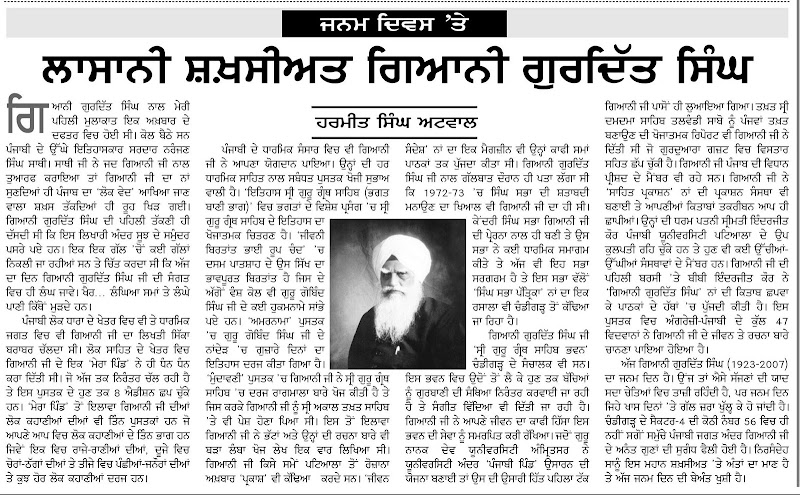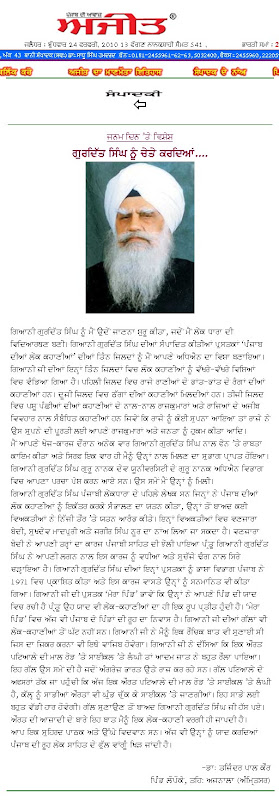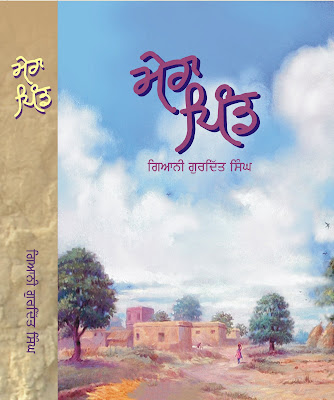Doordarshan Jalandhar organised a discussion on Giani Gurdit Singh’s Mera Pind, the classic which is in its 50th year of publication.
The discussion was compeered by Dr D B Rai, who teaches Punjabi at Jalandhar.
Prof Rajpal Singh, President Punjab Sahit Akademi, Punjab, and Roopinder Singh were the other panellists. It was first broadcast on February 7, 2011.
The video has now been put online:
Category: Uncategorized
Parkash @ Rs 17 a kilo
“We have managed to get some copies of Parkash,” said Devinder Singh. What he said was very important to me, personally, since my father, the late Giani Gurdit Singh, published Parkash, a newspaper in Punjabi, and for some years in Urdu, from 1947-1978.
The middle was published in published in The Tribune on January 24, 2011.
“Please call when you have the time, I have something for you,” said an SMS on my mobile phone. I was so busy that I didn’t even notice it, and called back a day later.
Now, in a typical Punjabi conversation you find out how everyone and everything is before you get to the crux of the matter. This conversation, too, took the same course.
In due course of time, the subject of the SMS came up. “We have managed to get some copies of Parkash,” said Devinder Singh, who has been responsible for digitising a large chunk of literature from the region and has pursued his goal with singular dedication.
The Nanakshahi Trust, of which is has been an energetic part, has been on this mission since 2001, the year Wikipedia was born, and it and has ratcheted up significant success in this endeavour.
What he said was very important to me, personally, since my father, the late Giani Gurdit Singh, published Parkash, a newspaper in Punjabi, and for some years in Urdu, from 1947-1978. It was a daily for many years, before turning into a weekly paper.
My father had a formidable collection of manuscripts, newspapers and books, but in part because of our having to move from one city to another, we do not have proper records of the paper of which he was the owner, printer, publisher and editor.
Since a few years, my mother, Mrs Inderjit Kaur, and I have tried to get copies of the newspaper, photocopies or otherwise. She is in touch with Sukhdev Singh of Ludhiana who has an archive of Singh Sabha Patrika, a monthly journal that my father edited from 1973 to 1988, but we have yet to come across someone who has preserved Parkash in this manner.
Naturally, as we were talking about the paper, my fingers got busy on the Internet, and in Google books I found a ‘Snippet view’ of an entry of Press in India (1965), published by the Registrar of Newspapers for India. Under the heading Circulation Levels, it said: “Among Punjabi dailies, the Parkash from Chandigarh had the highest circulation (8,110) in 1964.”
Now I work for a newspaper that is also published from Chandigarh and has the highest circulation in the region. On the way to office, I often drive past the building where Parkash was printed.
Devinder told me that his colleagues had traced a kabari- wala who had many papers of the 1960s and the 1970s with him, and among them were copies of Parkash.
While I don’t exactly know how he managed to get such old papers, it seems that these are a part of an estate sale of someone who had been a collector of old newspapers. Thanks to his passion, something of the past has been salvaged. But it was almost lost.
“We almost had a fight with the kabari wala last night,” said Devinder.
“Why? Was it over how much he wanted?”
“He reneged on the deal we had made and wanted more,” was Devinder’s reply.
“How much did he want?”
“We had agreed to give him Rs 17 per kg, but he wanted more. He broke his word, but then I thought of the value of what he had and we went back to him today,” said the digital archivist, his outrage obvious.
Even as I was soothing ruffled feathers, my mind leapt at the possibilities of resurrecting the times and moods of those decades, and reading some of my father’s Rajnitak Kundilias, the satirical poems that were memorised by many and are still quoted.
Thanks to a dedicated archivist, and a deal that did not go sour. Musty bundles of old newspapers are being examined, and soon they will be scanned and made available on the Internet. A digital light will illuminate an era gone by, as seen through varied visions published in newspapers, including Parkash.
The Ragmala issue
Is Ragmala Gurbani? Some feel it is not and point out that the Ragmala does not have reference to all the Ragas of the Sri Guru Granth Sahib, in fact, nine Ragas, i.e.
Manjh, Bihagra, Vad-hans, Jaitsri, Ramkali, Malli Gaura, Tukhari, Prabhati, and
Jaijawnti do not find any mention in the Ragmala. The relationship between the Ragas and Raganis, as explained in the Ragmala, does not correlate to Gurbani, since all the compositions in the Sri Guru Granth Sahib are in Ragas, and none in any Raganis.
On the other hand, others feel it is, since it is a part of most hand-written manuscripts and every copy of Sri Guru Granth Sahib that is now printed. But then, there is the historic meet of 1937, in which there was a discussion of a consultative committee of the Shiromani Gurdwara Parbandhak Committee. Scholars and religious leaders participated in it and among them was a young Giani Gurdit Singh.
The meet, where he spoke and after which he was offered a position in the Shiromani Gurdwara Parbandhak Committee, which he declined, further intensified the passion with which Giani Gurdit Singh researched on various aspects of Gurbani. His quest lasted a lifetime, and the result was literally thousands of articles, and many books, including Ithias Sri Guru Granth Sahib: Bhagat Bani Bhag, and later, another book, Mundavani, which proved controversial.
Visitors might find the following link, which has comments on and reviews of the book interesting. On this page, we have in English, the comments of the noted writer, Khushwant Singh; a review by Dr I J Singh of New York, which was published in the Sikh Review, and article by Mohinder Singh in India Journal, CA. In Punjabi, we have an article from the Ajit and five articles, published in the Atam Rang magazine.
Please click here to read more:
http://www.gianigurditsingh.com/whatcriticssay_mundavani.htm
Anniversary articles
Today, readers of the Punjabi Tribune read an article titled “Lasani Sakhiat Giani Gurdit Singh” by Harmit Singh Atwal.
The readers of Daily Ajit read a tribute, captioned “Giani Gurdit Singh Nu Cheate Kardian” by Dr Tejinder Pal Kaur.
Today is my father’s 87th birth anniversary. We remember him still—his work, his personality and his deeds have, indeed, left a lasting impact on the fabric of Punjab and in the collective consciousness of Punjabis.
I hope that you like the changes that my friends Rajiv, Cheena and Sandeep have done to the website to make it more contemporary and attractive.
Sikh Chic, the Canadian website has published HS Gill’s article, which is also a fitting tribute to Giani Gurdit Singh ji.
In the evening, at 7.30 pm IST, Doordarshan Jalandhar is telecasting a half-an-hour documentary on him. I will update you once I have seen it.
I really don’t have much more to add, other than that his heritage is cherished and alive, even after his is no longer with us physically.
You may like to click here to read more.
Please click on the images of the article to open bigger files that you can read or print out.
Roopinder Singh
 |
| From Website |
 |
| From Website |
Mera Bachpan translation
There is always a debate about whether translations can really capture the spirit of the original. For me, this debate was settled when I read the lucid translations of Plato’s dialogues by B. Jowett, who was Regius Professor of Greek in the University of Oxford. I can still recite some of the passages that I read in college, and there is not way that I could have read the original in Greek. Please click here to read more.
Giani ji’s anniversary
February 24 is the birth anniversary of Giani Gurdit Singh ji, my father. His books assured him literary immortality, his conduct and deeds have left such a deep impact on many lives that his memory is still very much with us. Please click here to read more
He made such a difference
Rabinder Singh Bhamra is one of the pillars of the Sikh community in New York. A much-respected businessman, he has a deep interest in Sikh thought and spirituality. Please click here to read Rabinder Singh Bhamra’s moving tribute to Giani ji:
Prof Harjit Singh Gill
Prof Harjit Singh Gill, Professor Emeritus, Jawaharlal Nehru University, New Delhi, has written about Giani Gurdit Singh ji. Prof Gill is a linguist of international standing and had interacted with Giani ji for a considerable period of time.
Please click here to read more about what Prof Gill writes about the man, his contribution and the impact that he left on the people around him.
Kirtan at home
Giani Gurdit Singh ji left us a year ago. On Thursday, January 17, 2008, the house that he build and where he lived the last many years of his life, was filled with the holy gurbani as members of the Akhand Kirtani Jatha recited shabads.
Those who were close to him had gathered to remember him. We were all there—my mother Sardarni Inderjit Kaur, my brother Ravinder and our families. This was essentially a private family function that had not been notified publicly, but then with Papa, things were informal.
Please click here to read more and see more photogaphs
Mera Pind, 8th edition published

Mera Pind, the classic by Giani Gurdit Singh ji has been reprinted because of popular and sustained demand for this book that has been in continuous print from 1961.
The new, eighth, edition is 480 pages and has been typeset again. It is now in a bigger type face and even the original graphics made by Ishwar Chitarkar, have been made bolder and better.
The cover illustration is by the artist R M Singh, who has been designing all the covers of Giani Gurdit Singh ji’s books for many years now. The background of a mud-covered house is taken from a photograph, shot by Roopinder Singh, of a house in Mithewal, the village that is Mera Pind.
The book has been printed on superior, imported paper and is available in both, soft cover and hardbound editions.